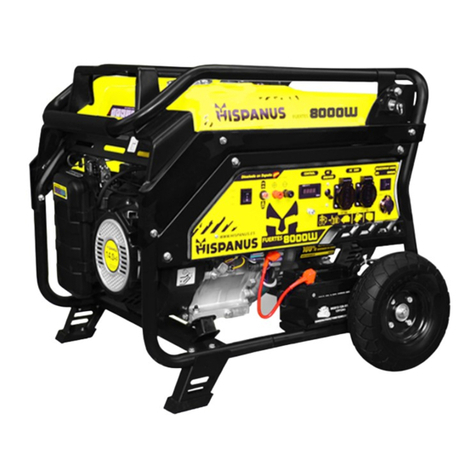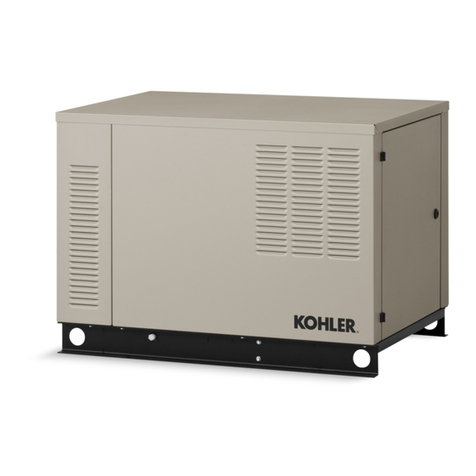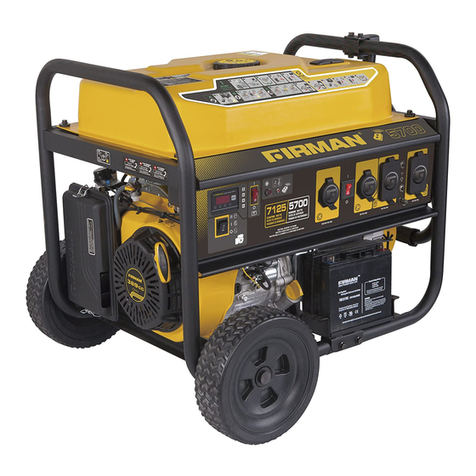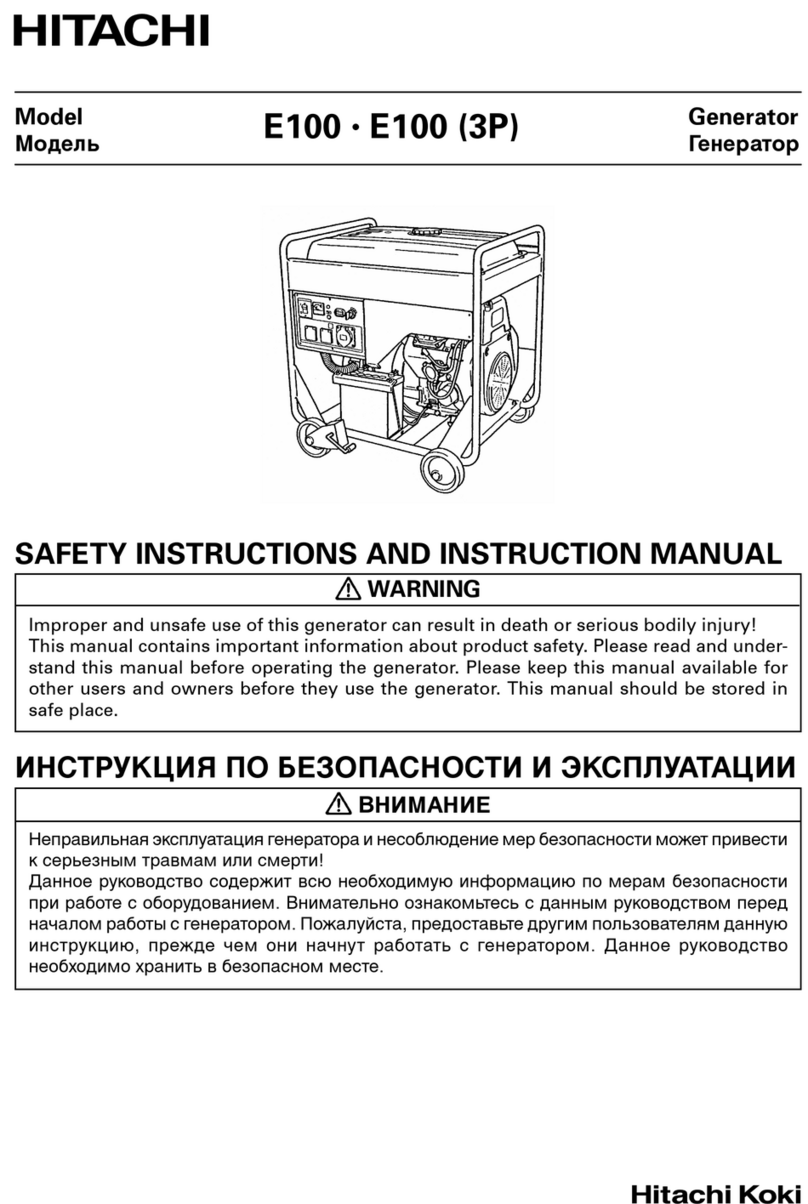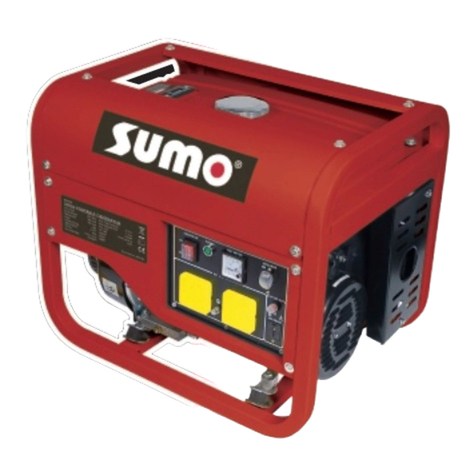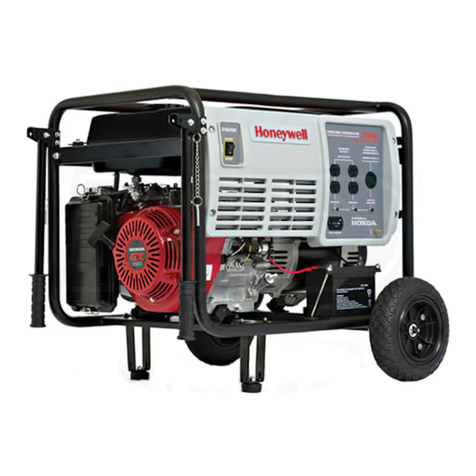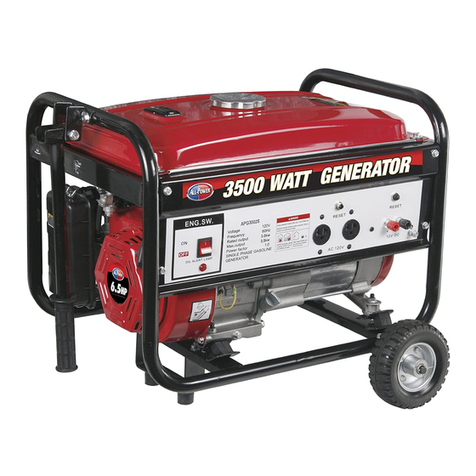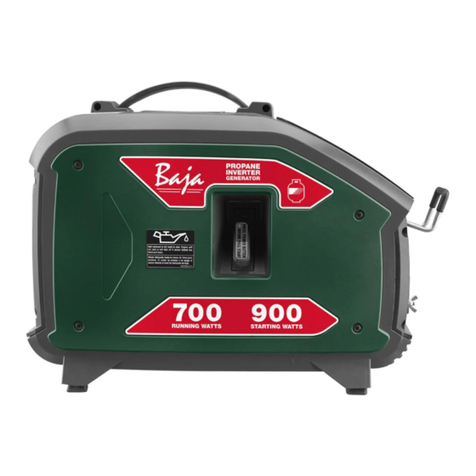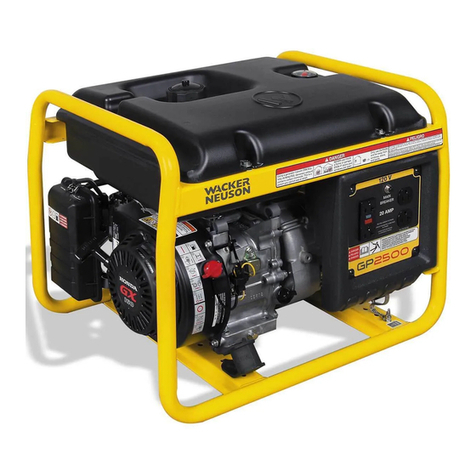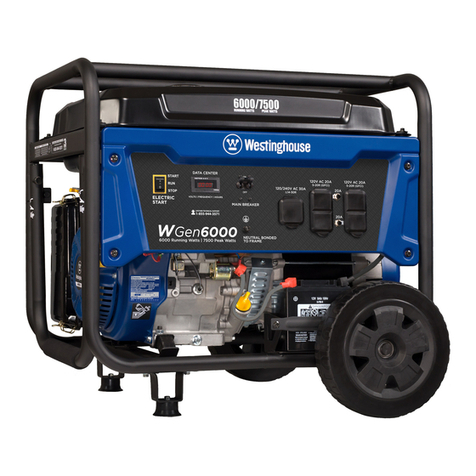HISPANUS LIGEROS-3500 User manual

HISPANUS GENERATOR
LIGEROS - FUERTES

MANUAL PARA
- FUERTES ATS/SOL
- LIGEROS 6000T (TRIFÁSICO)
- LIGEROS 7500T (TRIFÁSICO)

TABLE OF CONTENTS
WELCOME ................................................................................................................................................................ 2
SAFETY PRECAUTIONS ......................................................................................................................................... 2
ABOUT YOUR GENERATOR .................................................................................................................................. 3
1.1 UNPACKING ................................................................................................................................................. 3
1.1.1 ACCESSORY BOX ............................................................................................................................. 4
1.2 ASSEMBLY .................................................................................................................................................. 4
1.2.1 ASSEMBLING THE WHEEL KIT AND HANDLES .............................................................................. 4
1.3 KNOW YOUR GENERATOR ......................................................................................................................... 4
1.3.1 PRODUCT SPECIFICATIONS ............................................................................................................ 4
1.3.2 MAJOR COMPONENT........................................................................................................................ 5
1.3.3 ENGINE ASSEMBLY .......................................................................................................................... 5
1.3.4 CONTROL PANEL (FOR 50HZ ONLY) ............................................................................................... 5
1.4 HOW TO USE THE GENERATOR ................................................................................................................ 5
1.4.1 SYSTEM GROUND ............................................................................................................................. 5
1.4.2 GROUNDING THE GENERATOR ....................................................................................................... 6
1.4.3 CONNECTING ELECTRICAL LOADS ................................................................................................ 6
1.5 DON’T OVERLOAD THE GENERATOR ....................................................................................................... 6
OPERATION ............................................................................................................................................................. 6
2.1 BEFORE STARTING THE GENERATOR...................................................................................................... 6
2.1.1 ADDING ENGINE OIL ......................................................................................................................... 6
2.1.2 ADDING GASOLINE ........................................................................................................................... 7
2.2 TO START THE ENGINE .............................................................................................................................. 7
2.2.1 ELECTRIC STARTING........................................................................................................................ 7
2.2.2 REMOTE START (IF EQUIPPED) ....................................................................................................... 7
2.3 ATS CONTROL (IF EQUIPPED) ................................................................................................................... 7
2.3.1 OPERATING STEPS ........................................................................................................................... 7
2.3.2 LED INDICATOR DESCRIPTION ........................................................................................................ 8
2.4 STOPPING THE ENGINE ............................................................................................................................ 10
2.5 LOW OIL PRESSURE SHUTDOWN SYSTEM ............................................................................................ 10
2.5.1 RESTARTING ................................................................................................................................... 10
2.6 CHARGING THE BATTERY (IF EQUIPPED) .............................................................................................. 10
MAINTENANCE ...................................................................................................................................................... 10
3.1 MAINTENANCE SCHEDULE ...................................................................................................................... 10
3.2 GENERAL RECOMMENDATIONS.............................................................................................................. 10
3.2.1 GENERATOR MAINTENANCE ......................................................................................................... 11
3.2.2 ENGINE MAINTENANCE .................................................................................................................. 11
3.2.3 CHECKING OIL LEVEL .................................................................................................................... 11
3.2.4 CHANGING THE OIL AND OIL FILTER ............................................................................................ 11
3.2.5 REPLACING THE SPARK PLUG...................................................................................................... 11
3.3 SERVICE AIR CLEANER ............................................................................................................................ 11
3.4 CLEAN SPARK ARRESTOR SCREEN (IF EQUIPPED) ............................................................................. 11
3.5 GENERAL ................................................................................................................................................... 12
3.6 LONG TERM STORAGE ............................................................................................................................. 12
3.7 OTHER STORAGE TIPS ............................................................................................................................. 12
3.8 BATTERY REPLACEMENT (IF EQUIPPED) ............................................................................................... 12
TROUBLESHOOTING ............................................................................................................................................ 13
4.1 TROUBLESHOOTING GUIDE .................................................................................................................... 13
WARRANTY ............................................................................................................................................................ 14

DANGER
WARNING
CAUTION
WELCOME
Thank you for your purchase. We wish you years of success using your new generator.
This manual contains general warnings about the inherent risks of operating generators and specific warnings about the
operation and maintenance of this particular generator. In addition, it outlines important maintenance and storage procedures
as well as the limited warranty.
Please read this manual carefully before operating, maintaining, repairing, and storing your new generator.
THE INFORMATION CONTAINED HEREIN WAS BASED ON MACHINES IN PRODUCTION AT THE TIME OF PUBLICATION.
MANUFACTURER RESERVES THE RIGHT TO MODIFY THIS MANUAL AT ANY TIME.
SAFETY PRECAUTIONS
Throughout this manual, and on tags and decals affixed to the generator, DANGER, WARNING, CAUTION and NOTE blocks are
used to alert users to special instructions about a particular operation that may be hazardous if performed incorrectly. Observe
them carefully. Their definitions are as follows:
Indicates a hazardous situation or action which, if Not avoided, will result in
death or serious injury.
Indicates a hazardous situation or action which, if not avoided, could result in
death or serious injury.
Indicates a hazardous situation or action which, if not avoided, could result in
minor or moderate injury.
NOTE:
Notes contain additional information important to a procedure and will be found within the regular text body of this manual.
These safety warnings cannot eliminate the hazards that they indicate. Common sense and strict compliance with the special
instructions while performing the action or service are essential to preventing accidents.
Four commonly used safety symbols accompany the DANGER, WARNING and CAUTION blocks. The type of information each
indicates:
This symbol points out important safety information that, if not followed, could endanger personal safety and/or
property of others.
This symbol points out potential explosion hazard.
This symbol points out potential fire hazard.
This symbol points out potential electrical shock hazard.
GENERAL HAZARDS
• Never operate in an enclosed area or indoors.
• For safety reasons, the manufacturer recommends that the maintenance of this equipment is carried out by an Authorized
Dealer. Inspect the generator regularly, and contact the nearest Authorized Dealer for parts needing repair or replacement.
• Operate generator only on level surfaces and where it will not be exposed to excessive moisture, dirt, dust or corrosive
vapors.
• Keep hands, feet, etc., away from drive belts, fans, and other moving parts. Never remove any fan guard while the unit is
operating.
• Certain parts of the generator get extremely hot during operation. Keep clear of the generator until it has cooled to avoid
severe burns.
• Do NOT operate generator in the rain.
• Do not alter the construction of the generator or change controls which might create an unsafe operating condition.
• Never start or stop the unit with electrical loads connected to receptacles and with connected devices turned ON. Start the
engine and let it stabilize before connecting electrical loads. Disconnect all electrical loads before shutting down the
generator.
• Do not insert objects through unit’s cooling slots.
• When working on this equipment, remain alert at all times. Never work on the equipment when physically or mentally
fatigued.
• Never use the generator or any of its parts as a step. Stepping on the unit can stress and break parts, and may result in

dangerous operating conditions from leaking exhaust gases, fuel leakage, oil leakage, etc.
• On electric start models, disconnect the POSITIVE (+) battery cable from the engine starter or the NEGATIVE (-) battery cable
from the battery terminal, whichever is easier, before transporting the generator.
NOTE:
The generator muffler is equipped with a spark arrestor, which must be maintained in effective working order by the owner/
operator.
EXHAUST & LOCATION HAZARDS
• Never operate in an enclosed area or indoors! NEVER use in in partly enclosed areas such
as garages, even if doors and windows are open! ONLY use outdoors and far from open
windows, doors, vents, and in an area that will not accumulate deadly exhaust.
• The engine exhaust fumes contain carbon monoxide, which you cannot see or smell. This
poisonous gas, if breathed in sufficient concentrations, can cause unconsciousness or even
death.
• Adequate, unobstructed flow of cooling and ventilating air is critical to correct generator
operation. Do not alter the installation or permit even partial blockage of ventilation
provisions, as this can seriously affect safe operation of the generator. The generator MUST be operated outdoors.
• This exhaust system must be properly maintained. Do nothing that might render the exhaust system unsafe or in
noncompliance with any local codes and/or standards.
• Always use a battery operated carbon monoxide alarm indoors, installed according to the manufacturer instructions.
• If you start to feel sick, dizzy, or weak after the generator has been running, move to fresh air IMMEDIATELY. See a doctor, as
you could have carbon monoxide poisoning.
ELECTRICAL HAZARDS
• The generator produces dangerously high voltage when in operation. Avoid contact with bare wires, terminals, etc., while
the unit is running, even on equipment connected to the generator.
• Never handle any kind of electrical cord or device while standing in water, while barefoot or hands or feet are wet.
DANGEROUS ELECTRICAL SHOCK MAY RESULT.
• The National Electric Code (NEC) requires the frame and external electrically conductive parts of the generator be properly
connected to an approved earth ground. Consult with a local electrician for grounding requirements in the area.
• Use a ground fault circuit interrupter in any damp or highly conductive area (such as metal decking or steel work).
• Do not use worn, bare, frayed or damaged electrical cord sets with the generator.
• Before performing any maintenance on the generator, disconnect the engine starting battery to prevent accidental start up.
Disconnect the cable from the battery post indicated by a NEGATIVE, NEG or (–) first. Reconnect that cable last.
• In case of accident caused by electric shock, immediately shut down the source of electrical power. If this is not possible,
attempt to free the victim from the live conductor. AVOID DIRECT CONTACT WITH THE VICTIM. Use a non-conducting
implement, such as a rope or board, to free the victim from the live conductor. If the victim is unconscious, apply first aid and
get immediate medical help.
FIRE HAZARDS
• Gasoline is highly flammable and its vapor is explosive. Do not permit open flames, sparks or heat nearby while handling
gasoline.
• Never add fuel while unit is running or hot. Allow engine to cool completely before adding fuel.
• Never fill fuel tank indoors. Comply with all laws regulating storage and handling of gasoline.
• Do not overfill the fuel tank. Always allow room for fuel expansion. If tank is over-filled, fuel can overflow onto a hot engine
and cause FIRE or an EXPLOSION. Never store generator with fuel in tank where gasoline vapors might reach an open flame,
spark or pilot light (as on a furnace, water heater or clothes dryer). FIRE or EXPLOSION may result. Allow unit to cool entirely
before storage.
• Wipe up any fuel or oil spills immediately. Ensure that no combustible materials left on or near the generator. Keep the area
surrounding the generator clean and free from debris and keep a clearance of five (5) feet on all side to allow for proper
ventilation of the generator.
• Do not insert objects through unit’s cooling slots.
• Do not operate the generator if connected electrical devices overheat, if electrical output is lost, if engine or generator
sparks or if flames or smoke are observed while unit is running.
• Keep a fire extinguisher near the generator at all times.
ABOUT YOUR GENERATOR
1.1 UNPACKING

• Remove all packaging material.
• Remove separate accessories.
1.1.1 ACCESSORY BOX
Check all contents. If any parts are missing or damaged locate an authorized dealer.
2 – Fixed Wheels
2(1) – Handle Sets
2 – Large Flange Nuts
1 – Wrench Set
1 – Footing
6 – Flange Bolts
6 – Small Flange Nuts
4 – Large Washers
2 – Axles
1.2 ASSEMBLY
The generator requires some assembly prior to using it. If problems arise when assembling the generator, please contact the
nearest dealer.
1.2.1 ASSEMBLING THE WHEEL KIT AND HANDLES
The wheel kit is designed to greatly improve the portability of the generator. You will need the wrench and sleeve to install the
wheel kit:
NOTE:
The wheel kit is not intended for over-the-road use.
• Refer to the following photos and install the wheel kit and handles as follows:
• Slide the Axle through the Large Washer and insert it from the inside of the frame and Fixed Wheel and Large Washer. Then
secure wheel with nut and then repeat the steps on another wheel. Note orientation of wheel.
• Attach the footing. On the handle side of the generator, lift or support the bottom of the frame to enable the assembly of
the footing by using bolts and nuts.
• Attaching the handle. Start by installing the upper bolt and nut to hold the handle in place. Partially remove the handle pivot
bolt as shown to allow the insertion of the lower bolt. Next secure the upper and lower bolts by tightening them with the
wrenches or sockets.
1.3 KNOW YOUR GENERATOR
Read the entire Owner’s Manual and Safety Rules before operating this generator.
Compare the generator as below to become familiarized with controls and adjustments.
1.3.1 PRODUCT SPECIFICATIONS
MODEL
LIGEROS-3500
LIGEROS-6000(T)
LIGEROS-7500(T)
GENERATOR SPECIFICATIONS
Rated Power
2.8 KVA
5.0 KVA
6.5 KVA
Surge Power
3.5 KVA
6.0 KVA
7.5 KVA
Rated AC Voltage
230V, 230/400V
Rated Frequency
50 Hz @ 3000 RPM
Phase
Single/Three Phase
Gasoline Capacity
3.6 L
6.5 L
6.5 L
ENGINE SPECIFICATIONS
Rated Horsepower@ 3600 RPM
7 HP
13 HP
15 HP
Displacement
208 cc
389 cc
450 cc
Oil Type
See Chart in "Adding Engine Oil" Section
Oil Capacity
0.6 L
1.1 L
1.1 L
Run Time/Fuel Consumption
3h-100% load; 4h-50% load
3h-100% load; 3.5h-50% load
2.5h-100% load; 3h-50% load
MODEL
FUERTES-3500
FUERTES-6000(T)
FUERTES-7500(T)
GENERATOR SPECIFICATIONS
Rated Power
2.8 KVA
5.0 KVA
6.5 KVA

Surge Power
3.5 KVA
6.0 KVA
7.5 KVA
Rated AC Voltage
230V, 230/400V
Rated Frequency
50 Hz @ 3000 RPM
Phase
Single/Three Phase
Rated DC Voltage
12VDC
Battery Type
12 AH, 12VDC
18(20ATS) AH, 12VDC
18(20ATS) AH, 12VDC
Gasoline Capacity
15 L
25 L
25 L
ENGINE SPECIFICATIONS
Rated Horsepower@ 3600 RPM
7 HP
13 HP
15 HP
Displacement
208 cc
389 cc
450 cc
Oil Type
See Chart in "Adding Engine Oil" Section
Oil Capacity
0.6 L
1.1 L
1.1 L
Run Time/Fuel Consumption
7.5h-100% load; 14h-50% load
8h-100% load; 15h-50% load
7h-100% load; 13h-50% load
** Maximum wattage and current are subject to, and limited by, such factors as fuel Btu content, ambient temperature, altitude, engine
condition, etc.. Maximum power decreases about 3.5% for each 310 meters above sea level; and will also decrease about 1% for each 6℃
above 16℃ ambient temperature.
1.3.2 MAJOR COMPONENT
1. Muffler – Includes the spark arrestor and quiets the engine.
2. 12 Volt Sealed Battery (if equipped) – Used to start engine.
3. Fuel Shut Off – Between fuel tank and start grip. Turn off and run carburetor out of fuel for storage.
4. Fuel Tank – Tank holds 3.6-25L of fuel.
5. Fuel Gauge – Shows fuel level in tank.
6. Grounding Lug – Ground the generator to an approved earth ground. See "Grounding the Generator".
NOTE:
The battery shipped with the generator has been fully charged. A battery may lose its charge when not in use for prolonged
periods of time. If the battery is unable to ignite the engine, plug in the 12V charger (see the Charging the Battery section).
RUNNING THE GENERATOR WILL CHARGE THE BATTERY.
The positive battery wire was deliberately left detached for shipping. To operate the unit, attach this wire to the terminal on the
battery. Do not over-tighten. Slide the attached rubber boot over the battery post.
1.3.3 ENGINE ASSEMBLY
1. Choke Level – Used when starting a cold engine.
2. Start Grip – Controls the Start of generator if manual start.
3. Oil Fill – Check oil level and add oil here.
4. Air Cleaner – Filters intake air as it is drawn into the engine.
5. Spark Plug Location – The spark plugs ignite the Air/Fuel Mixture.
6. Oil Drain – Drain valve to remove used oil from the engine crankcase.
1.3.4 CONTROL PANEL (FOR 50HZ ONLY)
1. Heat Protector (if equipped) – Push-to-reset circuit breaker protects the socket against electrical overload.
2. Circuit Breaker – The generators are protected with a main circuit breaker to protect the generator against electrical
overload.
3. 3-in-1 Meter (if equipped) – Provides voltage and frequency value, and operating hours for Service Intervals.
4. 230 VAC, European Receptacle – Use each socket to power 230 Volt AC, single phase, 50 Hz electrical loads. Use only high
quality, well-insulated cord sets rated for 230 Volts. Keep extension cords as short as possible, preferably less than 15 feet
long, to prevent voltage drop and possible overheating of wires.
5. 400 VAC, Industrial Receptacle – Use each socket to power 400V AC, three phase, 50 Hz electrical loads. Use only high
quality, well-insulated cord sets rated for 400 Volts. Keep extension cords as short as possible, preferably less than 15 feet
long, to prevent voltage drop and possible overheating of wires.
6. ATS Mode select (if equipped) – Press the button to choose ATS control or not.
7. ATS Connector (if equipped) – Use a specified signal cable to connect the ATS.
1.4 HOW TO USE THE GENERATOR
If there are any problems operating the generator, please contact the nearest dealer. PAY ATTENTION TO “SAFETY
PRECAUTIONS”.
1.4.1 SYSTEM GROUND
The generator has a system ground that connects the generator frame components to the ground terminals on the AC output

receptacles. The system ground is bonded to the AC neutral wire in the generator control panel via a jumper wire.
Special Requirements
There may be some regulations, local codes, or ordinances that apply to the intended use of the generator.
Please consult a qualified electrician, electrical inspector, or the local agency having jurisdiction:
• In some areas, generators are required to be registered with local utility companies.
• If the generator is used at a construction site, there may be additional regulations which must be observed.
Connecting to a Building’s Electrical System
Connections for standby power to a building’s electrical system must be made by a qualified electrician. The connection must
isolate the generator power from utility power or other alternative power sources and must comply with all applicable laws and
electrical codes.
1.4.2 GROUNDING THE GENERATOR
The local Code requires that the frame and external electrically conductive parts of this generator be properly connected
to an approved earth ground.
Local electrical codes may also require proper grounding of the unit. For that purpose, connecting a stranded copper wire to the
grounding lug and to an earth-driven copper or brass grounding rod (electrode) provides adequate protection against electrical
shock. However, local codes may vary widely. Consult with a local electrician for grounding requirements in the area.
Proper grounding of the generator will help prevent electrical shock in the event of a ground fault condition in the generator or
in connected electrical devices. Proper grounding also helps dissipate static electricity, which often builds up in ungrounded
devices.
1.4.3 CONNECTING ELECTRICAL LOADS
DO NOT mixed connect different voltage and phase and frequency of loads to generator.
• Let engine stabilize and warm up for a few minutes after starting.
• Plug in and turn on the desired Volt AC, phase, Hz electrical loads.
• See “Don’t Overload the Generator”.
1.5 DON’T OVERLOAD THE GENERATOR
Overloading a generator in excess of its rated wattage capacity can result in damage to the generator and to connected
electrical devices. Observe the following to prevent overloading the unit:
• Add up the total wattage of all devices to be connected at one time. This total should NOT be greater than the generator's
wattage.
• The rated wattage of lights can be taken from light bulbs. The rated wattage of tools, appliances and motors can usually be
found on a data label or decal affixed to the device.
• If the appliance, tool or motor does not give wattage, multiply volts times ampere rating to determine watts (volts x amps =
watts).
• Some electric motors, such as induction types, require about three times more watts of power for starting than for running.
This surge of power lasts only a few seconds when starting such motors. Make sure to allow for high starting wattage when
selecting electrical devices to connect to the generator:
1. Figure the watts needed to start the largest motor.
2. Add to that figure the running watts of all other connected loads.
OPERATION
2.1 BEFORE STARTING THE GENERATOR
Prior to operating the generator, engine oil and gasoline will need to be added, as follows:
2.1.1 ADDING ENGINE OIL
Use no special additives. Select the oil's viscosity grade according to the expected operating temperature (also see chart).
• Above 40°F, use SAE 30
• Below 40°F and down to 10°F, use 10W-30
• Below 10°F, use synthetic 5W-30
Any attempt to crank or start the engine before it has been properly serviced
with the recommended oil may result in an engine failure.
• Place generator on a level surface.

• Clean area around oil fill and remove dipstick.
• Slowly fill engine with oil through the oil fill opening until it reaches the full mark of dipstick. Stop filling occasionally to check
oil level.
• Install dipstick. Check engine oil level before starting each time thereafter.
2.1.2 ADDING GASOLINE
Do not light a cigarette or smoke when filling the fuel tank.
Never fill fuel tank indoors. Never fill fuel tank when engine is running or hot. Avoid spilling gasoline on a hot engine.
Allow engine to cool entirely before filling fuel tank.
Do not overfill the fuel tank. Always leave room for fuel expansion. If the fuel tank is overfilled, fuel can overflow onto a
hot engine and cause FIRE or EXPLOSION. Wipe up any spilled fuel immediately.
• Use regular UNLEADED gasoline with the generator engine. Do not mix oil with gasoline.
• Do not use gasoline with more than 10% alcohol such as E85 or Methanol.
• Clean area around fuel fill cap, remove cap.
• Slowly add unleaded regular gasoline to fuel tank. Fill to bottom of screen filter. Be careful not to overfill.
• Install fuel cap and wipe up any spilled gasoline.
IMPORTANT: It is important to prevent gum deposits from forming in fuel system parts such as the carburetor, fuel hose or tank
during storage. Alcohol-blended fuels (called gasohol, ethanol or methanol) can attract moisture, which leads to separation and
formation of acids during storage. Acidic gas can damage the fuel system of an engine while in storage. To avoid engine
problems, the fuel system should be emptied before storage of 30 days or longer. See the "Storage" section. Never use engine
or carburetor cleaner products in the fuel tank as permanent damage may occur.
2.2 TO START THE ENGINE
Never start or stop engine with electrical devices plugged into the receptacles and devices turned on.
• Unplug all electrical loads from the unit's receptacles before starting the engine.
• Make sure the unit is in a level position.
• Open the fuel shut-off valve. The fuel valve locates under the fuel tank.
• If the engine is cold, move the Choke Lever to ON position. If the engine is warm, move the Choke Lever to the CLOSED/OFF
position.
NOTE:
If engine fires, but does not continue to run, pull choke level to “Full Choke” and repeat starting instructions.
IMPORTANT: Do not overload the generator. Also, do not overload individual panel receptacles. These outlets are protected
against overload with circuit breakers. See “Don’t Overload the Generator” carefully.
2.2.1 ELECTRIC STARTING
• Push the button to the START position and hold for 2 seconds until the generator started. If the unit fails to started, please
wait 15 seconds before restart.
NOTE:
For manual starting: Push the switch in panel to the ON position. Pull the Starter Grip gently until you feel slight resistance,
then pull briskly. Don’t let the Starter Grip snap back.
• As the engine warms up, move the Choke Lever to CLOSED/OFF position.
• Confirm that each electrical device has been turned off before plugging it into your generator.
2.2.2 REMOTE START (IF EQUIPPED)
• Make sure the button in ON position before remote control.
• Push the ON button on control unit and hold for 2 seconds until the generator
started. If the unit fails to started, please wait 15 seconds before restart.
NOTE:
Use distance is within 30 meters. It may be effective in greater distance. Change the
battery in control unit when it is ineffective.
2.3 ATS CONTROL (IF EQUIPPED)
ATS is commonly used at home, bank, base station, etc. It will start the generator automatically while city power cut out. Please
operate the ATS as follows:
2.3.1 OPERATING STEPS

• ATS Mode select (if equipped): Turn the MODE SELECT button to ATS position on the control panel.
• Connecting: Use provided signal cable to connect generator and ATS. Connect ATS to generator socket and city power and
home wire as the diagram. Ask electrician if necessary.
• AUTO setting: Press AUTO transfer button, AUTO pilot on the panel lights. The ATS operating system will be in the state of
automatic inspection.
• Running: The default of power supply is city power (HOUSE NET pilot). If the city power system fails to supply power, and
HOUSE NET pilot is off. The generator will be started in 2 seconds and warms up for 5 seconds. After that, ATS switches to
generator power supply, and the GENERATOR pilot lights.
• Ternary cycle starting: If the generator starts failure as a result of low temperature or other reasons, the ATS control system
will execute ternary cycle starting as follows: First time, the generator starts for 3 seconds. Second time, the generator
restarts for 4 seconds after paused 5 seconds. Third time, the generator restarts for 5 seconds after paused 5 seconds. After
that, FAILURE pilot will be on. Please press the Auto transfer button to close fault alarm.
• Generator shutting: If city power restored over 10 seconds, and HOUSE NET pilot is on. ATS will automatically transfer to city
power, and the generator will be stopped after 5 seconds of non-loaded with GENERATOR pilot on. If request generator
stops in state of AUTO mode, please turn to MANUAL position, the generator will be stopped at once.
• Manual: If AUTO function is not needed, please turn to MANUAL position.
2.3.2 LED INDICATOR DESCRIPTION
• HOUSE NET pilot turns red while city power accesses.
• GENERATOR pilot turns green while generator output.
• AUTO pilot turns green while push auto transfer button.
• FAILURE pilot turns red if started failure for three times or stopped at low fuel or others.


2.4 STOPPING THE ENGINE
• Shut off and unplug all electrical loads from generator receptacles. Never start or stop the engine with electrical devices
plugged in.
• Let engine run at no-load for several minutes to stabilize the internal temperatures of engine and generator.
• Push the button to the “Stop/Off” position. For remote shutoff: Push the OFF button on the remote controller.
• Close fuel valve.
2.5 LOW OIL PRESSURE SHUTDOWN SYSTEM
The engine is equipped with a low oil pressure sensor that shuts down the engine automatically when the oil pressure drops
much. A delay built into the low oil shutdown system allows oil pressure to build during starting. The delay allows the engine to
run for about 10 seconds before sensing oil pressure. If the engine shuts down by itself and the fuel tank has enough gasoline,
check engine oil level.
2.5.1 RESTARTING
If trying to restart the engine within 10 seconds after it shuts down, the engine may NOT start. The system needs 5 to 10
seconds to reset. If the engine is restarted after such a shutdown and the low oil pressure has not been corrected, the engine
will run for about 10 seconds as described above and then stop.
2.6 CHARGING THE BATTERY (IF EQUIPPED)
Do not permit open flame, sparks or heat around a battery. Wear protective goggles, rubber apron and rubber gloves
when working around a battery. Battery electrolyte fluid is an extremely corrosive sulfuric acid solution that can cause severe
burns. If spill occurs, flush area with clear water immediately.
Storage batteries give off explosive hydrogen gas while recharging. An explosive mixture will remain around the battery
for a long time after it has been charged. The slightest spark can ignite the hydrogen and cause an explosion. Such an
explosion can shatter the battery and cause blindness or other serious injury.
Use battery charger plug to keep the battery charged and ready for use. Battery charging should be done in a dry location.
1 Connect charger to “Battery Charger Input” plate. Plug wall receptacle end of the battery charger into a Low Volt AC wall
outlet.
2 Unplug battery charger from wall outlet and control panel jack when generator is going to be in use.
NOTE:
Do not use the battery charger for more than 48 hours at one charge.
3.1 MAINTENANCE SCHEDULE
Follow the calendar intervals. More frequent service is required when operating in adverse conditions noted below.
Check Oil Level
At Each Use
Change Oil and Oil Filter(Change oil after first 30 hours of operation then every season.)
*Every Season/Every 100 Hours
Clean Spark Arrestor Screen
*Every Season/Every 100 Hours
Service Air Cleaner
*Every Season/Every 100 Hours
Replace Spark Plug
*Every Season/Every 100 Hours
*Change oil and oil filter every month when operating under heavy load or in high temperatures. Clean more often under dirty or dusty operating conditions.
Replace air cleaner parts if very dirty.
3.2 GENERAL RECOMMENDATIONS
The warranty of the generator does not cover items that have been subjected to operator abuse or negligence. To receive full
value from the warranty, the operator must maintain the generator as instructed in this manual.
Some adjustments will need to be made periodically to properly maintain the generator.
All adjustments in the Maintenance section of this manual should be made at least once each season. Follow the "Maintenance
Schedule".
NOTE:
Once a year replace the spark plugs and replace the air filter. New spark plugs and a clean air filter assure proper fuel-air
mixture and help the engine run better and last longer.
MAINTENANCE

3.2.1 GENERATOR MAINTENANCE
Keeping the unit clean and dry. Operate and store the unit in a clean dry environment where it it is away from excessive dust,
moisture or any corrosive vapors. Cooling air slots in the generator must not become clogged with snow, leaves, or any other
foreign material.
Check the cleanliness of the generator often and clean when dust, oil, moisture or other foreign substances are visible on its
exterior surface.
Never insert any object or tool through the air cooling slots, even if the engine is not running.
NOTE:
DO NOT use garden hose to clean generator. Water can enter the engine fuel system and cause problems. In addition, if water
enters the generator through cooling air slots, some water will be retained in voids and crevices of the rotor and stator
winding insulation. Water and dirt buildup on the generator internal windings will eventually decrease the insulation
resistance of these windings.
3.2.2 ENGINE MAINTENANCE
When working on the generator, always disconnect negative cable from battery. Also, disconnect spark plug wires from
the spark plugs and keep the wires away from spark plugs.
3.2.3 CHECKING OIL LEVEL
See the “BEFORE STARTING THE GENERATOR” section for information on checking the oil level. The oil level should be checked
before each use, or at least every eight hours of operation. Keep the oil level maintained.
3.2.4 CHANGING THE OIL AND OIL FILTER
Change the oil and filter after the first 30 hours of operation. Change the oil every 100 hours or every season thereafter. If
running this unit under dirty or dusty conditions, or in extremely hot weather, change the oil more often.
Hot oil may cause burns. Allow engine to cool before draining oil. Avoid prolonged or repeated skin exposure with used
oil. Thoroughly wash exposed areas with soap. Use the following instructions to change the oil:
• Clean area around oil drain cap.
• Remove oil drain cap from the drain hose and dipstick to drain oil completely into a suitable container.
• When oil has completely drained, install oil drain cap and tighten securely.
• Place a suitable container beneath the oil filter and turn filter counterclockwise to
remove. Discard according to local regulations.
• Coat gasket of new filter with oil. Turn filter clockwise until gasket contacts lightly with
filter. Then tighten an additional 3/4 turn.
• Fill engine with recommended oil and replace the dipstick. (See “Before Starting the
Generator” for oil recommendations).
• Wipe up any spilled oil.
• Dispose of used oil at a proper collection center.
3.2.5 REPLACING THE SPARK PLUG
Replace the plugs once each year. This will help the engine start easier and run better.
1 Stop the engine and pull the spark plug wires off of the spark plugs.
2 Clean the area around the spark plugs and remove them from the cylinder heads.
3 Set the spark plug gaps to .76 mm (0.030 in.). Install the correctly gapped spark plug into each cylinder head.
4 Push the boots firmly on the spark plugs.
3.3 SERVICE AIR CLEANER
The engine will not run properly and may be damaged if using a dirty air cleaner. Clean or replace the air cleaner paper filter
every 200 hours or once a year . Clean or replace more often if operating under dusty conditions. To clean or replace paper air
filter:
• Remove air cleaner cover and remove paper filter.
• Clean paper filter by tapping it gently on a solid surface. If the filter is too dirty, replace it with a new one.
• Clean air cleaner cover. Next insert new paper filter into the base of the air cleaner. Re-install air cleaner cover.
NOTE:
To order a new air filter, please contact the nearest authorized dealer.
3.4 CLEAN SPARK ARRESTOR SCREEN (IF EQUIPPED)

The engine exhaust muffler has a spark arrestor screen. Inspect and clean the screen at least once each year. If unit is used
regularly, inspect and clean more often.
If using the generator on any forest-covered, brush-covered or grass-covered unimproved land, it must equipped with a
spark arrestor. The spark arrestor must be maintained in good condition by the owner/operator.
Clean and inspect the spark arrestor when the engine is at ambient temperature as follows:
Loosen the clamp and remove the spark arrestor screen from the muffler.
• Inspect screen and replace if torn, perforated or otherwise damaged. DO NOT USE a defective screen. If screen is not
damaged, clean it with commercial solvent.
• Replace the spark arrestor and secure with the clamp.
3.5 GENERAL
The generator should be started at least once every seven days and be allowed to run at least 30 minutes. If this cannot be done
and the unit must be stored for more than 30 days, use the following information as a guide to prepare it for storage.
NEVER store engine with fuel in tank indoors or in enclosed, poorly ventilated areas where fumes may reach an open
flame, spark or pilot light as on a furnace, water heater, clothes dryer or other gas appliance.
Allow unit to cool entirely before storage.
3.6 LONG TERM STORAGE
It is important to prevent gum deposits from forming in essential fuel system parts such as the carburetor, fuel hose or tank
during storage. To avoid engine problems, the fuel system should be emptied before storage of 30 days or longer, as follows:
• Remove all gasoline from the fuel tank.
Drain fuel into approved container outdoors, away from open flame. Be sure engine is cool. Do not light a cigarette in the
vicinity.
• Start and run engine until engine stops from lack of fuel.
• Allow the engine to cool, then drain oil from crankcase. Refill with recommended grade.
• Remove spark plugs and pour about 1/2 ounce (15 ml) of engine oil into each cylinder.
• Install and tighten spark plugs. Do not connect the spark plug wires.
• Clean the generator outer surfaces. Check that cooling air slots and openings on generator are open and unobstructed.
• Store the unit in a clean, dry place.
3.7 OTHER STORAGE TIPS
• Do not store gasoline from one season to another.
• Replace any gasoline can that starts to rust. Rust and/or dirt in the gasoline will cause problems with the carburetor and fuel
system.
• If possible, store the unit indoors and cover it to give protection from dust and dirt. Cover the unit with a suitable protective
cover that does not retain moisture.
• BE SURE TO EMPTY THE FUEL TANK. If it is not practical to empty the fuel tank and the unit is to be stored for some time,
use a commercially available fuel stabilizer added to the gasoline to increase the life of the gasoline.
NEVER cover the generator while engine and exhaust area are warm.
3.8 BATTERY REPLACEMENT (IF EQUIPPED)
NOTE:
The battery shipped with the generator has been fully charged. A battery may lose some of its charge when not in use for
prolonged periods of time. If the battery is unable to crank the engine, plug in the 12V charger included in the accessory box
(see the Charging a Battery section). RUNNING THE GENERATOR WILL CHARGE THE BATTERY.
Drain fuel into approved container outdoors, away from open flame. Be sure engine is cool. Do not smoke in
the vicinity or light a cigarette.
• Remove the battery wire connections (black wire first) and the battery hold-down bracket.
• Replace the battery, connecting the RED wire to the POSITIVE (+) terminal and the BLACK wire to the NEGATIVE (-)
terminal.

TROUBLESHOOTING
4.1 TROUBLESHOOTING GUIDE
PROBLEM
CAUSE
COLLECTION
Engine is running, but no AC output is
available.
1. Circuit breaker is open.
2. Poor connection or defective
cord set.
3. Connected device is bad.
4. Fault in generator.
5. GFCI trips the 20 Amp outlet.
1. Reset Circuit breaker.
2. Check and repair.
3. Connect another device that is in good condition.
4. Contact Authorized Service Facility.
5. Repair the ‘short’ and reset the GFCI.
Engine runs good but bogs down
when loads are connected.
1. Short circuit in a connected
load.
2. Generator is overloaded.
3. Engine speed is too slow.
4. Shorted generator circuit.
1. Disconnect shorted electrical load.
2. See ‘Don’t Overload the Generator’.
3. Contact Authorized Service Facility.
4. Contact Authorized Service Facility.
Engine will not crank.
1. Battery weak or dead.
1. Recharge or replace battery (see ‘No Battery
Charger DC Output’ at bottom of guide).
Engine will not start, or starts and
runs rough.
1. Fuel shut-off is off.
2. Dirty air cleaner.
3. Out of gasoline.
4. Stale gasoline.
5. Spark plug wire not connected
to spark plug.
6. Bad spark plug.
7. Over-choking.
8. Low oil level.
9. Excessive rich fuel mixture.
10. Intake valve stuck open or
closed.
11. Engine has lost compression.
1. Fuel shut-off is on.
2. Clean or replace air cleaner.
3. Fill fuel tank.
4. Drain fuel tank and fill with fresh fuel.
5. Connect wire to spark plug.
6. Replace spark plug.
7. Put choke knob to No Choke position.
8. Fill crankcase to proper level.
9. Contact Authorized Service Facility.
10. Contact Authorized Service Facility.
11. Contact Authorized Service Facility.
Engine shuts down during operation.
1. Out of gasoline.
2. Low oil level.
3. Fault in engine.
1. Fill fuel tank.
2. Fill crankcase to proper level.
3. Contact Authorized Service Facility.
Engine lacks power.
1. Load is too high.
2. Dirty air filter.
3. Engine needs to be serviced.
1. See ‘Don’t Overload the Generator’.
2. Replace air filter.
3. Contact Authorized Service Facility.
Engine ‘hunts’ or falters.
1. Choke is opened to soon.
2. Carburetor is running too rich
or too lean.
1. Move choke to halfway position until engine runs
smoothly.
2. Contact Authorized Service Facility.

No battery charger DC output.
1. Battery posts are corroded.
2. Battery cable is bad.
3. Battery is defective.
4. Receptacle is bad.
5. Battery charger in-line
fuse(1.5A) melted open.
1. Clean battery posts.
2. Replace cable.
3. Check battery condition, replace if defective.
4. Contact Authorized Service Facility.
5. Replace fuse with identical 1.5A replacement fuse
only (located inside control panel).
WARRANTY
HISPANUS generators are manufactured and distributed by HISPANUS LTD. HISPANUS shall warranty any piece of
equipment manufactured, or parts of equipment manufactured, to be free from defects in material or workmanship for a
period of 1 year from the date of purchase by user. This warranty applies to the original purchaser of the equipment and is
non transferable. Verification of purchase is the responsibility of the buyer in the form of a sales receipt for the specific
product. Parts will be replaced or repaired at no charge, except when the equipment has failed due to lack of proper
maintenance or abuse. Any misuse, abuse, alteration or improper installation or operations will void warranty.
Determining whether a part is to be replaced or repaired is the sole decision of HISPANUS.
NOTE:
Some services performed by parties other than HISPANUS may void warranty. Always contact HISPANUS Customer
Support at sat@hispanus.es prior to having any service or warranty work performed, as some services performed by
parties other than HISPANUS approved service centers may void warranty.
This warranty covers parts only. It will not provide for replacement of complete products due to defective parts.
Components not manufactured by HISPANUS such as engines are guaranteed by their manufacturer and can be serviced
at factory-authorized locations near you. The engine warranty is covered under the terms and conditions as outlined by
the engine manufacturers warranty contained herein and is the sole responsibility of the engine manufacturer. Normal
engine maintenance such as spark plugs, air filters, adjustments, fuel system cleaning and obstructions due to build up is
not covered by this HISPANUS warranty. HISPANUS will not provide for replacement of complete products due to
defective parts.
Any costs incurred due to replacement or repair of items outside of an HISPANUS approved facility is the responsibility of
the buyer and not covered under warranty. Transportation costs to and from service center is the responsibility of the
buyer/customer. HISPANUS can supply you with the service center location in your area by contacting HISPANUS
customer support.
For warranty service, find the nearest Authorized Service Dealer by email: [email protected].
This warranty specifically excludes the following; failure of parts due to damage caused by accident, fire, flood, windstorm,
acts of God, applications not approved by HISPANUS in writing, corrosion caused by chemicals, use of replacement parts
which do not conform to manufacturer’s specifications, damage related to rodent and/or insect infestation, and damage
caused by vandalism. Additional exclusions: loss of running time, inconvenience, loss of income, or loss of use, including
any implied warranty of merchantability of fitness for a specific use. Also, Outdoor Power Equipment needs periodic
parts and service to perform well, and this warranty does not cover instances when normal use has exhausted the life of a
component or the engine.
Warranty does not cover items subject to normal wear such as tires, receptacles or any part subject to direct physical
contact by the public. This warranty does not cover any personal injury or damage to surrounding property caused by
failure of any part. Repair or replacement of parts does not extend the warranty period.
THIS WARRANTY IS IN LIEU OF ANY OTHER WARRANTY EXPRESSED OR IMPLIED AND HISPANUS. ASSUMES NO OTHER
RESPONSIBILITY OR LIABILITY OUTSIDE THAT EXPRESSED WITHIN THIS WARRANTY.
THERE IS NO OTHER EXPRESSED WARRANTY. ANY AND ALL IMPLIED WARRANTIES ARE EXCLUDED. LIABILITY FOR
CONSEQUENTIAL DAMAGES UNDER ANY AND ALL WARRANTIES ARE EXCLUDED TO THE EXTENT EXCLUSION IS PERMITTED

BY LAW.
HISPANUS
Calahorra (La Rioja)
c.p. 26500
España
Tel.:+34-941148926
Servicio tecnico: sat@hispanus.es
Equipo comercial: ventas@hispanus.es
This manual suits for next models
4
Table of contents
Other HISPANUS Portable Generator manuals
Popular Portable Generator manuals by other brands
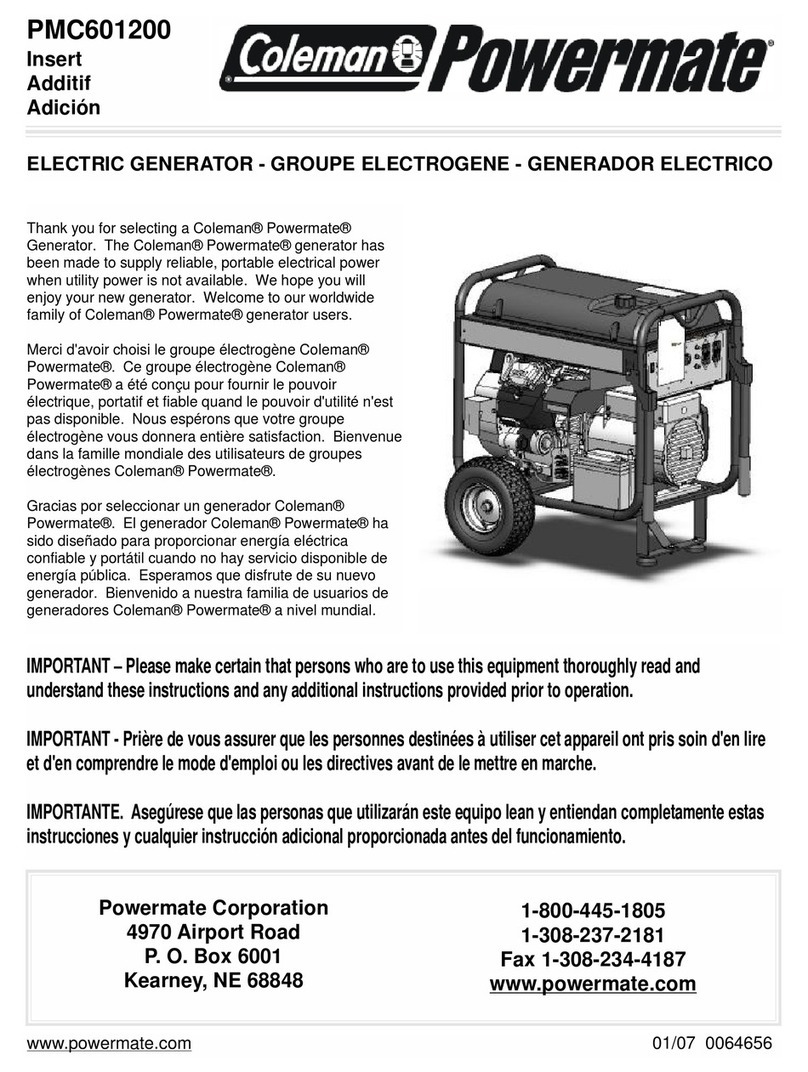
Powermate
Powermate PMC601200 owner's manual
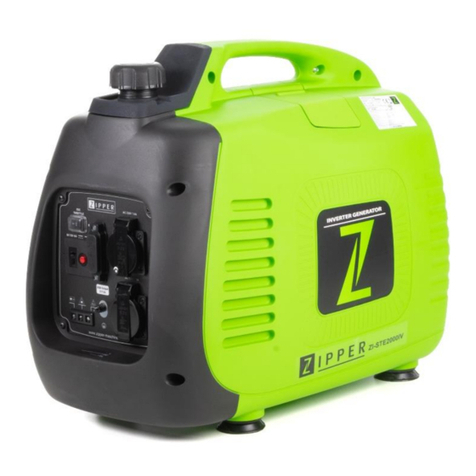
Z.I.P.P.ER MASCHINEN
Z.I.P.P.ER MASCHINEN ZI-STE2000IV user manual
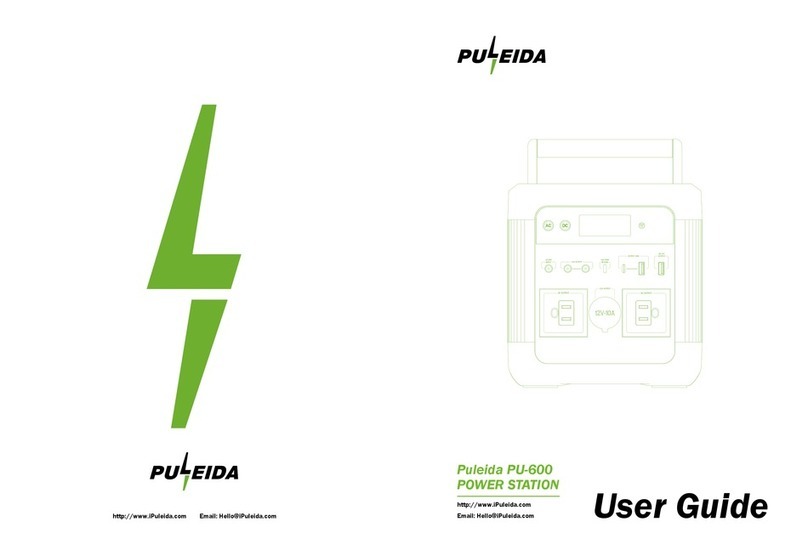
Puleida
Puleida PU-600 user guide
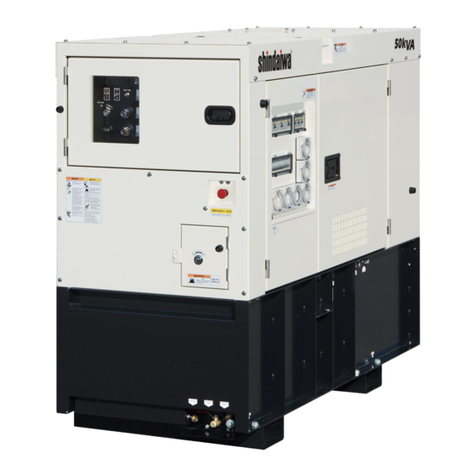
Shindaiwa
Shindaiwa DG50MK-P Owner's and operator's manual
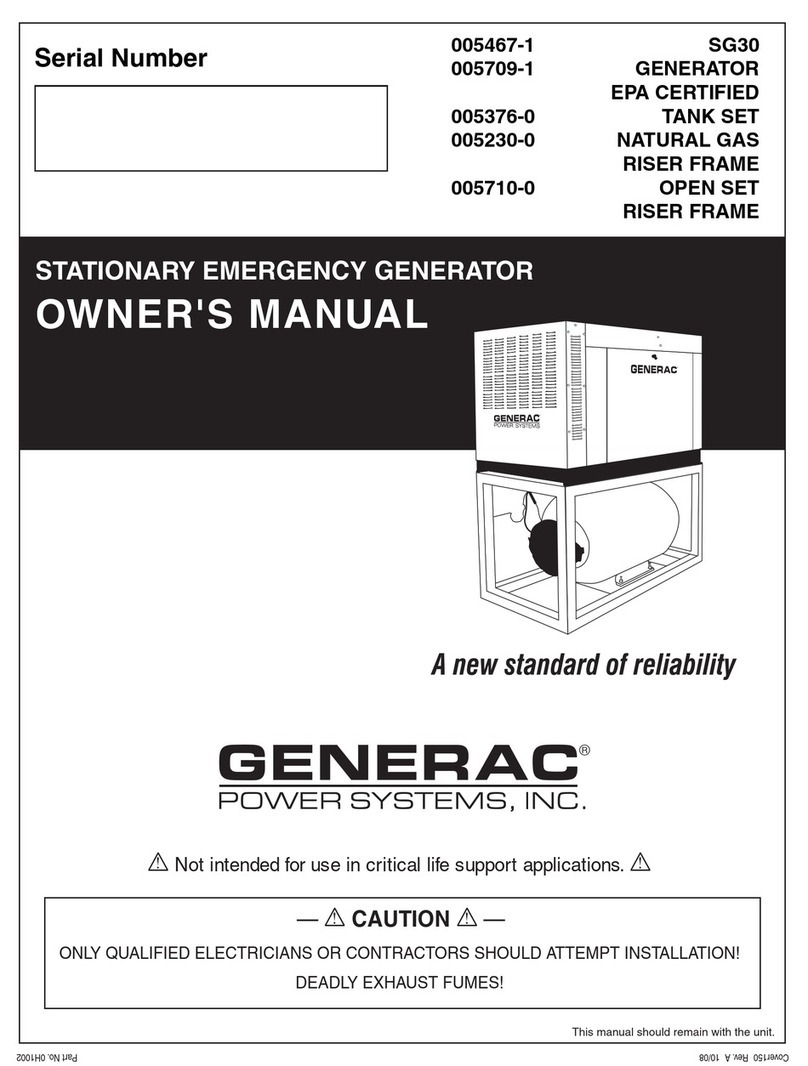
Generac Power Systems
Generac Power Systems 005467-1 owner's manual

Sportsman
Sportsman GEN2000LP instruction manual
